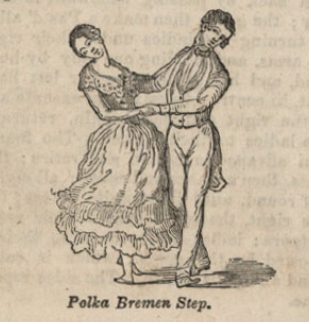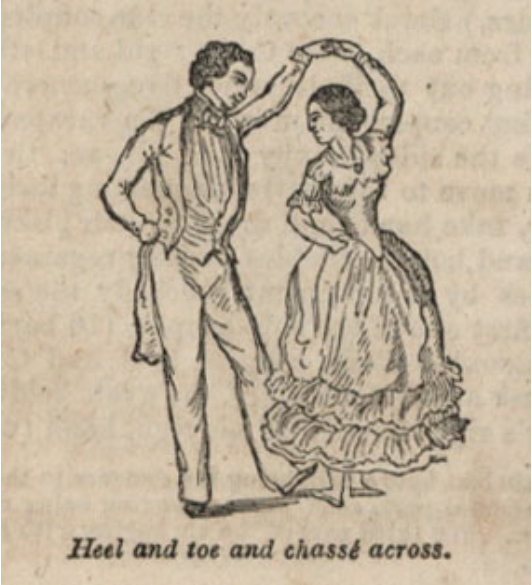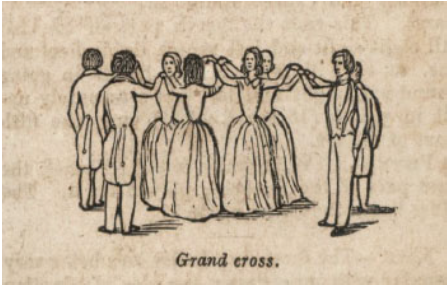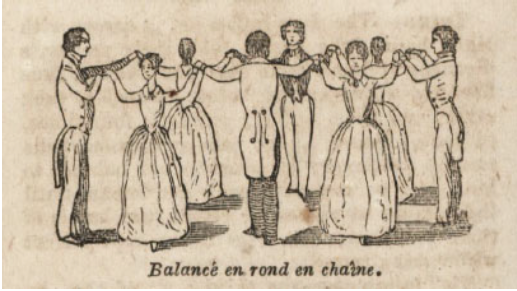From Durang’s Terpsichore and also The Ball-Room Bijou, by Charles Durang, Philadelphia.
Both books were copyrighted 1847 and printed in 1848.
Reconstruction by Richard Powers
Русский перевод здесь
This polka quadrille commemorates the early battles of the Mexican-American War (1 846-1848), which was still in progress when Durang composed this quadrille. The war was declared by President James Polk, who interestingly, was rumored to have won the 1844 election because of the immense popularity of the Polka in America that year. The Battle of Monterey, California, saw some the earliest action of the war, in September, 1 846. Charles Durang wrote that this quadrille is "commemorative of one of our most brilliant triumphs in arms."
- All steps are polka steps, unless otherwise noted, with one polka step per bar of music.
- The polka step is a "materially modified" New York Step or Butler Trot, that Durang said is like the hop waltz (sauteuse), meaning with a small jete instead of a glissade on count 1, like a "Scotch jig step." He said this modification was the result of "accidental invention, by our dancers."
- Heel and toe balances occur throughout Durang's polka quadrilles. Like any balance, they are an expression of individuality, which in this case will mean heel & toe with either foot. The only exception is if the choice of foot might kick toward your partner or another dancer, so we may advise: balance on any foot that doesn't kick someone. A double balance (heel & toe twice with the same foot) is sometimes specified below, as a choice in this reconstruction, but overall the balances are spontaneous choices.
First: GEN. TAYLOR (General Zachery Taylor)
bars
8 All honor partners, honor corners
 4 Head couples Forward Four, advancing 2 polka steps, holding inside hands at shoulder level, then double heel & toe balance.
4 Head couples Forward Four, advancing 2 polka steps, holding inside hands at shoulder level, then double heel & toe balance.
4 And retire to places.
4 Heads forward again with demi chaine anglaise (half right and left), offering right hand to vis-a-vis, and left hand to partner, forming a circle of hands-4, with ladies facing out and gents facing in.
4 Allemande balance: Heel and toe balance twice to partner, raising those arms, then to vis-a-vis.
8 Keep partner's left hand and give R hand over L (crossed hands) to balance in place (1 bar), then do a crossed-hand polka (the gent passes by in front of his partner on the first turning polka step, to commence the rotation) around the inside of the set, for one full tour. End four-in-line thusly: Original head couple keeps their left hands, with the gent ending up on the inside of the line. Bottom couple keeps their right hands, with the lady ending up in the inside, taking hands with the head gent. Inside two face side couple #3; outside two dancers face side couple #4.
4 Heel & toe balance twice to partners; balance twice away.
4 One-hand turn forward with partner, around to end four-in-line again.
4 Each head polkas forward to allemande (swing by one hand) with vis-a-vis corners. Center two keep inside hands, to split the side couple. Outside two envelop the other side couple.
4 Heads back to center of set to allemande partners with other hand.
2 Head couples take partners in waltz position, with gents facing out of the set, double heel & toe balance in place.
6 Then polka around to original places.
48 Sides repeat the same.
Second - GEN. WORTH (General William Jenkins Worth)
8 Introduction music.
4 Head couples ladies half-chain. Head ladies advance with 2 polkas, then heel & toe balance in the
center.
4 Continue the half chain turning the opposite man by the left hand.
8 Turn the gents into a half-chain (no heel & toe), turning partner by the left hand one full turn,
in opposite places, so that gents end up in the center, four-in-line, facing partners.
4 Ladies balance right heel & toe then polka to the right, with arms folded in front. Left heel & toe then polka to the left.
4 Gents balance in the same way, beginning right.
8 "All hey, or straight right and left” four-in-line: With arms folded in front, left heel & toe partner and pass toward the left, then right, then to the left, to approach vis-a-vis (3 polkas). Right heel & toe then pass to the right, then to the left, to home places.
|
|
Note: There are two ways to interpret straight right and left, passing right shoulders, as in grand right and left chain, or passing to the right diagonal. The illustration shows passing right shoulders.
32 Sides repeat the same figure.
Third - GEN. TWIGGS (General David Emmanual Twiggs)
4 Introduction music. Note: Durang doesn't specify how many bars of music to wait for this figure, and the tune chosen for this figure happens to have a four-bar intro.
2 Head couples polka forward, taking inside hands, beginning right feet (optional).
2 Give right hand to vis-a-vis and turn halfway around, facing back to home place at the end.
2 Give left hand and turn halfway back, then let go of hand, still facing toward home.
2 Partners take inside hands, lady on the left, and head forward toward home, gent taking the
nearest corner lady by her left hand to form three-in-line facing out.
2 Close hands-three to form a circle.
2 Ladies arch while the gent goes forward under, all three facing out.
2 All three heel & toe balance right and left.
2 The gent backs under to circle-three formation.
4 Gent raises right arm and leads his partner under the arch and around to place (he turns to follow her, under his own arch).
4 Gent raises his left arm and leads the corner lady under and around, ending three-in-line facing out.
4 All chasse to the right (3 side and close), and back to the left.
4 Corner lady returns home (assisted by her partner), and head couple turns to place. Wheel around turning halfway clockwise, then the gent passes his partner to his right-hand side.
 8 4 ladies advance to the center with 2 polkas R&L, solo
8 4 ladies advance to the center with 2 polkas R&L, solo
balance R&L, retire L&R polkas, double balance partner, who balances in reply.
8 Gents advance to the center with polkas L&R, balance L&R, turn right halfway to approach partner with 2 polkas, balance partner, taking waltz position.
4 All 8 polka a quarter circle around to the right of the set (circling line-of-dance).
4 Continue with pursuit (lady backs) to the opposite side of the set.
8 Continue with the Coquette, lady leading, chasing home to partners.
48 Repeat, with the side couples beginning the figure.
Fourth - CAPT. BRAGG (Captain Braxton Bragg)
8 Introduction music.
6 Head couple polka around the center of the set, traveling once and a quarter, to end facing their right-side corner couple, opening out side-by-side at the end.
2 Taking hands-4, double heel & toe balance.
8 Head gent then polkas with the corner lady, to the opposite head couple and repeats.
8 Head gent then polkas with the opposite lady, to the last side couple and repeats.
8 Head gent then polkas with that side lady, to his home place.
4 Wait four measures, as gents walk into the set, face partners, to take them in waltz position.
 16 All promenade around the set with the Polka Bremen step.
16 All promenade around the set with the Polka Bremen step.
However Durang never described that step, so you may subsitute your favorite 1 840s polka variation.
It's better if it looks like his illustration:
32 The third (right side) gent executes the same figure.
20 All wait 4 bars, then promenade around the set as before.
32 The second (opposite head) gent executes the same figure.
20 All wait 4 bars, then promenade around the set as before.
32 The fourth (left side) gent executes the same figure.
20 All wait 4 bars, then promenade around the set as before.
Fifth - COL. MAY (Colonel Charles Augustus May)
8 Introduction music.
1st)
4 Begin le grand Quarre: Heads forward with 2 polkas to meet vis-a-vis and heel & toe balance to them taking hands-4. Meanwhile, sides chasse to corners of the square with 3 slides and a close, then heel & toe balance toward vis-a-vis, standing opposite.
4 Heads take vis-a-vis by 2 hands and chasse 3 slides to side's places, then and heel & toe balance. Meanwhile, sides polka forward to the head's original places, and heel & toe balance to vis-a-vis, facing into the set. Arms are akimbo when dancing solo.
8 Sides do what the heads did, and vice-versa, to home places.
 2nd)
2nd)
8 All couples take high right hands with partners, heel and toe and chasse, 4 times, around in place, perhaps with the lady turning under the gent's raised arm. Let go of hands at the end.
3rd)
4 Ladies enter center of set to form a right-hand star, as
gents turn solo to the right to offer left hand to partner's left hand, to form the grand cross. Then ladies double heel & toe balance R, then balance partners.
|
|
(Note that this illustration shows the gents facing the wrong way.)
4 Ladies star forward one place, as gents remain in place, then balance to the next gents.
8 Continue around, ladies meeting each gent and balancing.
4th)
3 Ladies star forward to give partners left hands and continue forward to form a circle with the ladies facing out, gents facing in, to form the balance en rond en chaine.
1 And end with one heel & toe balance.
|
|
4 Turn partners by the left hand once around, offering right hands over left at the end of the turn.
8 Raise held right hands and heel & toe and chasse with partners, 4 times around in place, as above.
End facing partners in home place.
16 Keep right hands, and commence a grand right and left chain, beginning with a heel & toe
balance then one polka step to pass, continuing to balance each that you meet, to home place.
5th)
8 All polka around the set.
78 Repeat the figure, with side couples leading forward as head couples chasse sideways
© Richard Powers 1983 and 2014




